
|   |

|   |
2nd edition of Samarpana: The Asian Festival of Classical Dance - Dr. Sunil Kothari e-mail: sunilkothari1933@gmail.com Photos courtesy: Samarpana Festival October 15, 2013 During the 2nd edition of Samarpana, the Asian Festival of Classical Dance, produced by Sruti Laya school of Bharatanatyam in Singapore under the guidance of its director Gayatri Sriram, one at once notices that it is an international arts platform where, as claimed by the organizers 'sensibilities, sense and the sublime come alive.' The presentation was not limited to classical Bharatanatyam dance form only. Sruti Laya and event organizer Jyoti Ramesh of Jade Group along with the sponsors BSI, Orbis, Passion Card, Mudrika Foundation for Indian Performing Arts, Bengaluru, media partner Tabla, the Tagore Society of Singapore, and several well wishers, have a large canvas of performing arts. The scope of the three-day festival included celebrated Indian classical Dhrupad singers Gundecha Brothers in collaboration with Kumudini Lakhia, internationally renowned Kathak exponent, guru and choreographer with her dance company Kadamb from Ahmedabad, collaboration of Flamenco Sin Fronteras with guest artist Miguel Angel Espino and JSLN Company, three segments of Bharatanatyam, Contemporary (Zaini Tahir and NUS Dance, French ballet academy L'Academie du Danse, Singapore and a special lecture by V Sriram, the noted musicologist and cultural historian from India on 'The Devadasis of George Town' and a panel discussion on 'Dilution of classical arts' by experts from various fields. The sumptuous fare was offered on a silver platter from 27th till 29th September 2013 at the Drama Centre Theatre, National Library Building, Singapore. On the opening night, India's leading musicians of the Dhrupad tradition, the Gundecha Brothers Umakant and Ramakant accompanied on pakhavaj by Akhilesh Gundecha and on tanpura by Nirantan Gundecha and Sanjeev Jha, wove a web of magic of musical sound with their slow alap as is performed traditionally in Dhrupad. The dignity and the serious manner with which they elaborated the alap was a measure of their artistic height they have achieved in their distinguished career. It was a coming together for the first time of Dhrupad and Kathak. Earlier, they have collaborated with late Chandralekha in her choreographic work Sharira. It created history as both the iconoclastic dancer, exploring frontiers of not only Bharatanatyam, but also of dance employing physical traditions of Yoga and South Indian martial art Kalaripayattu of Kerala to the accompaniment of Dhrupad singing by the Gundecha Brothers, revealed possibility of a daring collaboration in the field of dance and classical music. Even earlier, the Gundecha Brothers had collaborated with contemporary dancer Astad Deboo in his explorations of movement in his choreographic work imbued with a deep feeling of prayer. This openness to participate with dancers has won Gundecha Brothers great respect. The dancers and the musicians show complete respect for each other and the art forms, journeying together enhancing the emerging form with such collaboration. Therefore, when the musicians and choreographer Kumudini Lakhia, known for her catholic approach in Kathak, agreed to undertake such a collaborative work together, a lot of expectations were raised on part of the rasikas. The music aficionados and the dance buffs were eager to see the resultant artistic work. Suffice it to say that both the Gundecha Brothers and Kumudini Lakhia with her well trained dancers more than fulfilled the expectations. 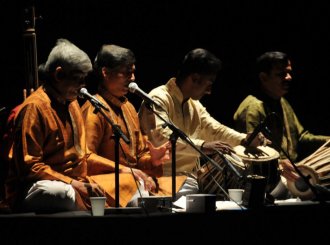 Gundecha Brothers 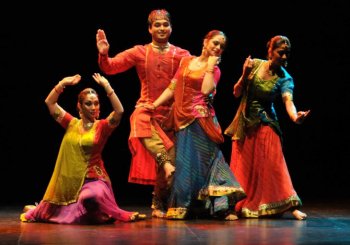 Kadamb Titled Dhruv Gati, the work rose to heights in a seamless manner. In alap, the salient features of Kathak in terms of the slow, small movements of wrists, arms, the swing of bodies in keeping with the dhira, gambhira, slow and dignified pace of raga went hand in hand, creating soothing visual images. The curves generated by the arms of dancers, took visual shape of the curves of the swaras, musical notes. The movements of the dancers resembled those of birds. The element of improvisation seeped in with the speed of the swaras. The accompanying sound of pakhavaj and tabla was imaginatively used by the dancers to take pirouettes. The introduction of tatkar, the footwork in drut gati (fast speed) appeared perfect. Alternating arm movements, bodily formations and traditional development of jod and jhala gave enough scope to dancers to display their virtuosity. Tabla accompaniment by Joby Roy was in perfect synchronization. As a choreographer, Kumudini showed how Kathak movements gave visual shape to the music notes. The literary bandish in Malkauns, the text with Shankar Giirijapati, Parvati parameshavara, Jaya Ganesh, Lambodar, Shankarsuta offered dancers scope to evoke those images with finesse and grace. Lord Shiva's image with Ganga flowing from his hair, the female dancer enacting role of Parvati, the other two female dancers praying as devotees, made for excellent tableaus to explore the visual images. The tihais performed by dancers pat on sam were arresting. The solo play of pakhavaj brought in exquisite sound texture. One experienced joy which was as it were of watching, listening for the first time. This ananubhuta, 'not ever experienced' joy was the reward for the rasikas. Kumudini Lakhia had selected as an interlude between the two ragas of Dhrupad, her choreographic work of 1978 titled Yugal, to the music by late composer Atul Desai, with instrumental music, strains of sitar by seasoned sitarist Manju Mehta (sister of Vishwa Mohan Bhatt) and additional music on sarod. The male dancer Souvik Chakraborty stands in the centre and female dancer Sanjukta Sinha circling round him, covering the entire stage in breathtaking pirouettes brought down the house. The use of Kathak movements within tradition but in a novel manner has been the signature of Kumudini Lakhia. The intra forms of Kathak tode, tukde, parans and tatkar have been employed in this vintage work with imagination. With the synergy created by the male and female dancers as a pair, Yugal, even today after 35 years of its first presentation, seems refreshing. Many imitations have been seen in the succeeding years in Kathak choreography, proving Kumudini Lakhia's leading role as innovator. The dancers unleashed energy with high voltage winning them rounds of applause. The crescendo was palpable. Though performed to recorded music, the piece was received by the audience with unqualified enthusiasm. After exposition of Hamir Kalyan, Gundecha brothers sang Dhamar Hori in Dhamar tala. The light designer Murugan, who was specially invited for lighting created the festive mood of Hori with imagination. The pink colour of gulal as it were coloured the sky. The sahitya, bandish, describing the mood of Hori, playing with colours transported the audience to Braj. The dancers Sanjukta Sinha, Bhakti Dani and Rupanshi Kashyap Thakkar enacted the play of Hori, the young male dancer costumed as Krishna and the female dancers clothed in colorful costumes evoked the visuals of miniature paintings. The syringe full of coloured water seemed to be spraying colour on the gopis, who in turn surrounded Krishna and smeared him with colours. At times the group of three gopis, and lone Krishna in a corner, or otherwise four of them holding hands dancing together, in a joyous mood evoked spirit of Hori to the mesmerizing music by Gundecha Brothers. The footwork, tatkar rising to crescendo, enhancing the Dhrupad music and the finale with finish of respective creators, the musicians, and the choreographer through her dancers, was thrilling. The audience gave them a standing ovation. Thus Samarpana's opening night became a truly memorable evening. The presentation of Samarapan Citation 2013 to honour Madam Som Said, a choreographer, instructor, director with more than 40 years of experience followed. Mrs. Vijay Thakur Singh, the High Commissioner of India, gave her the citation. A short documentary on life and work of Madam Som Said was screened before the presentation. 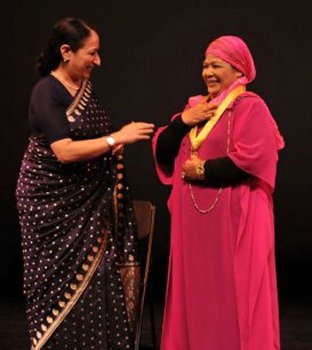 Mdm Som Said with Mrs. Vijay Thakur Singh 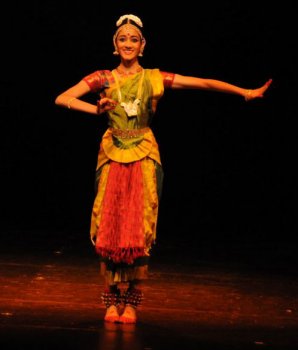 Diya Gopalan In order to focus attention on a young emerging talented dancer, Samarpana Festival presents a dancer of Sruti Laya in a solo Bharatanatyam recital. This year Diya Gopalan, a student of Gayatri Sriram for the past eight years, performed Sankhya, a thematic presentation based on the decimal system of counting, dovetailing various Indian philosophies and beliefs in narration. Diya is blessed with a commanding stage presence, a pleasant visage and immense passion for dance, youth coursing through her frame. Choreography was by Minal Prabhu and Gayatri Sriram. Pushpanajli was based on number one representing Nirakara Parabrahma, pure consciousness. From then on, succeeding numbers wove mythological stories, highlighting philosophical concepts with brief narration. The concept of duality as epitomized in Purush and Prakriti with Ardhanarishwara icon was danced in an arresting manner. The Trinity of Shiva, Vishnu and Brahma, the Chatur Vedas and Panchabhootas were woven in format of a varnam. These were imaginatively choreographed and danced with commendable stamina, never showing any stress. It was a delight to see someone so young going through the paces to the exacting nattuvangam by her mentors and excellent team of musicians including Balasubramanyam Sharma (vocal), G Gurumurthy (percussion) and K Jayaram (flute). It enhanced the appeal of dance, for Diya seemed to be completely immersed in the music. The six seasons Shadritu gave her scope for expressing reactions caused by the environment on a young maiden. Then followed Saptaswaras, seven musical notes. The eight directions, the presiding deities, the Ashtadikpalas suggested cosmos to whom the dancer paid obeisance. Diya covered the stage competently. Navarasas, the nine sentiments found in Diya's beautiful face a playground, where the expressions seemed to fleet effortlessly. The finale was tillana with Dasavatara, ten incarnations, which Diya danced with aplomb and verve. Here is a dancer who gives one and all an impression that she is born to dance and is bound to go places. Following Diya Gopalan's performance was the presentation on 'The Devadasis of George Town,' an illustrated talk by V Sriram, the much sought after speaker on history and fine arts. He has been doing considerable work on the history of Chennai and Carnatic music and writes frequently on these subjects for The Hindu and Madras Musings. Author of nine books including Carnatic Summer on the lives of twenty two exponents, he with his erudition, deep knowledge of Carnatic music, sound sense of history and an amazing style of keeping his audience riveted to his discourse, regaled the audience with the story of the Devadasis. He gave rare information, screening photos and excerpts of music of artistes of bygone era. The banning of dance in the temples, the anti-nautch movement, the efforts of E Krishna Iyer and Rukmini Devi to re-establish Bharatanatyam on a high pedestal, the fantastic story of Bangalore Nagaratnamma, her fierce temperament and independence as a female, the pathetic conditions of the devadasis - all was told in a manner which kept his audience spellbound. Samarapana deserves congratulations for such a wonderful discourse. V Sriram should be invited every year from Chennai to the Samarpana festival to share his knowledge with old and young generation. 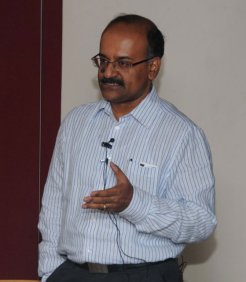 V Sriram 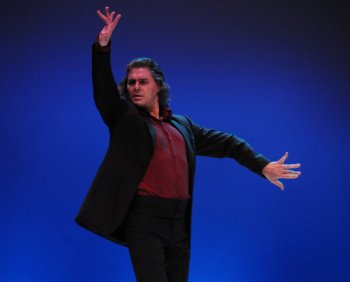 The Cruel Gardens 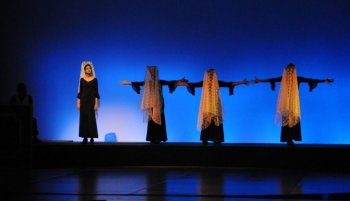 The Cruel Gardens 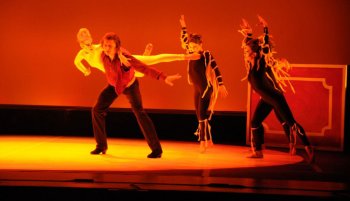 The Cruel Gardens The final program on 2nd evening was presentation of The Cruel Gardens, a collaboration of Flamenco Sin Fronteras with guest artist Miguel Angel Espino and JSLN Company. The Spanish poet Garcia Lorca wrote in 1935, a haunting elegy of the goring and death of a bullfighter, his dear friend. The Cruel Gardens, contemporary work, an allegorical exploration of the psyche within a bullfight, expresses the struggle between a man's inner self and outer ego, his animal instinct against his spiritual mind. Lorca's poem is interspersed in dance punctuating within scenes recited by a narrator in English and five Flamenco dancers with strong footwork typical of Flamenco energetically reaffirm the tragedy. Flamenco dancer / choreographer Antonio Vargas with his innovative approach deals in his choreography with the inevitable death – locked as the bull fighter and the bull are in a combat, symbolically suggesting intertwining of the beast and man, faced with punishment, brave bull fighting till death, when the final moment of truth dawns upon them. It was energetically performed by the handsome Italian dancer Miguel Espino with precision. Known for his ability to rouse crowds, he unleashed power, arrogance, confidence with his frame, taut like a bow, hands arching over head, feet pounding on the floor, conveying the quintessential element of Flamenco. Soren Niewelt in role of bull exuded power and tragedy. Contemporary dancers, the dancer impersonating Spirit of Mother Bull, created the excitement of bullfight arena. On the final day of the festival, Feathered Fables were presented in order to give an opportunity to the dancers trained in Bharatanatyam by Sruti Laya, to participate with other young dancers of different genre of dance and display their sound training. Selecting story from Jataka tales in which different births of Lord Buddha are described, Gayatri Sriram choreographed the tale of Golden Mallard whose daughter had to choose a husband from many birds, but she selects the vain peacock against her father's advice. Performed in Kalakshetra 'bani 'of Bharatanatyam the tale unfolded elegantly and the dancers dressed in simple costumes, performed in a disciplined manner. 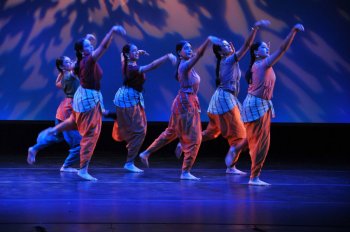 Sruti Laya in Golden Mallard 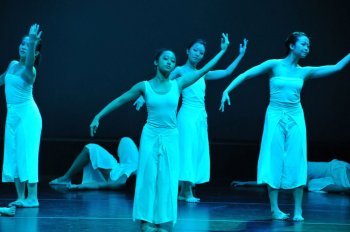 NUS Dance Ensemble in Simurgh Local contemporary dancer, choreographer trained also in ballet and jazz, Zaini Mohammad Tahir has had training in classical Indonesian dance and shares his love for Asian dance movement. The young dancers from NUS Dance Ensemble, presented Simurgh inspired by Farid Attar's mysterious Sufi poem 'Conference of the Birds' journeying through various facets from birth till death, which showed their talent in group work under Zaini's competent choreography. Jonathan Guillarme, a choreographer from Paris, now settled in Singapore working with L'Academie du Danse choreographed in a brief ballet Jonathan Livingston Seagull with some seven young ballet dancers from tiny tots to elder ones showcasing their classical ballet training. Gayatri Sriram's aim is to collaborate, connect and grow with performances that range from classical Bharatanatyam to folk, contemporary and ballet. The attempt to bring these diverse dance troupes together is a praiseworthy goal, as it expands the area of performance and does not limit to Bharatanatyam only.  L'Academie du Danse 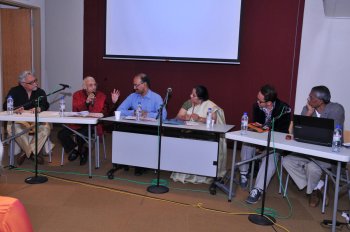 Panel discussion Back to back, like previous day's talk by V Sriram, was a panel discussion on the theme of 'Dilution of the classical arts' covering state of classical art forms and how some adapt, some adopt and some transplant successfully on their journey across borders. Moderated by Dr. Prasenjit Duara, the Raffles Professor of Humanities and Director of Asia Research Institute at National University of Singapore, the participants were V Sriram, musicologist and historian, Minal Prabhu, Bharatanatyam guru and choreographer, Zaini Tahir, young Resident Choreographer of NUS Dance Ensemble, J P Nathan, Director of Programming, Esplanade Theatres on the Bay, Singapore and dance historian, author and critic Dr. Sunil Kothari. From the discussion by the experts, it was agreed upon that classical arts need not be diluted, and if so, they do not remain classical and are out of the present discourse. Yes, adapting, adopting has helped the classical arts to grow with changing times, but the core value of its classicism does not admit of dilution. Some forms of classical singing in Carnatic music have no takers and would disappear. Minal Prabhu observed that by adapting and adopting proper changes, Bharatanatyam under the vision of Rukmini Devi, has raised the bar of the form in terms of classical dance. J P Nathan placed his point of view as a program director about his problem of being not loyal to any form, be it classical or otherwise. With innovations, experimentation, explorations how does one look at this issue? From among audience, Gayatri Sriram questioned about the hallmark of a classical form vis-a-vis changes which if they cross the limits, place classical arts in a tight corner. Question of audience training, role of media, the niche audience for classical arts were discussed. Movement like SPICMACAY bringing the classical arts to young generation was referred to. Also the need for audience for classical arts against the various popular arts distracting audiences was discussed. A stimulating thought provoking session. If time permits and resources are available, both V Sriram's talk and the panel discussions need to be published as a part of its serious activity, which Samarpana has undertaken. 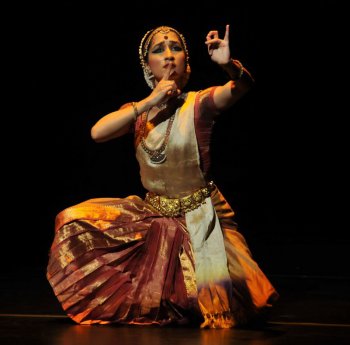 Amirita Lahiri
Amrita has selected songs carefully keeping the original music composed by Gurudev himself, with music score by young talented composer Kuldip Pai. The lyrics of Gurudev have an eternal universal appeal. Like a vaggeyakar, his songs with exquisite music have been a part of shared tradition, a legacy which crosses narrow linguistic borders and touches the hearts of the rasikas. Amrita also selected English passages written by Tagore to link up the various episodes, which helped the narrative for those not familiar with Bengali songs. The lighting by Murugan, in particular when Chitrangada is transformed into a beautiful woman was imaginative and the audience gave a round of applause spontaneously. Amrita has received training in Kuchipudi under Vempati Chinna Satyam's disciple Anuradha Nehru. She further studied under Swapnasundari and at present continues to take intensive training under Kishore Mosalikanti. She has also trained in Bharatanatyam under Leela Samson. With an attractive stage presence, young and sprightly Amrita succeeds in highlighting the Vempati bani admirably with quicksilver movements and elegant postures. She strives to imbibe the spirit of the dance form that challenges her to rise to great artistic heights. With command over technique, Amrita has carved a niche for herself as a brilliant Kuchipudi exponent. Her interpretation of Chitrangada in a solo narrative form was further embellished with brevity and selection of appropriate verses which had a natural flow along with both Bengali and English prose passages. The tillana with 'Esho Shyamalo sundaro' in Desh raga concluded her solo rendering. The three day festival has now become an important landmark in the cultural calendar of Singapore. The concept of bringing a variety of cultural expressions involving Singapore's multiracial community with a broad vision would surely find enthusiastic response. It is an auspicious beginning and one looks forward to Samarpana's succeeding editions gaining further strength.  Dr. Sunil Kothari is a dance historian, scholar, author and a renowned dance critic. He is Vice President of World Dance Alliance Asia Pacific India chapter, based in New Delhi. He is honored by the President of India with Padma Shri, Sangeet Natak Akademi award and Senior Critic Award from Dance Critics Association, NYC. He is a regular contributor to www.narthaki.com, the roving critic for monthly magazine Sruti and is a contributing editor of Nartanam for the past 12 years. Response * Dr. Sunil Kothari reports the discussion about 'Dilution of classical arts' in Narthaki- and proceeds further to mention the conclusion, “It was agreed upon that classical arts need not be diluted”... the intrigue is furthered by the next sentence, “if so, they do not remain classical and are out of the present discourse” and lastly ends with a sentence “classicism does not admit dilution” – Perfect. One should appreciate the efforts of the organizers like Samarpana to have considered discussing the all important topic. We need to go further: Who would accept to deliberately “diluting” classical dance? Even if they do, who would bell the cat? After all being a guru is not some official position that comes with legal authority and power to dismiss or suspend a dancer. The dancers themselves have to be watchful and alert themselves to the very possibility of “dilution” (if it can be defined). - Bhavanvitha Venkatesh (Oct 22, 2013) Post your comments Pl provide your name and email id along with your comment. All appropriate comments posted with name and email id in the blog will also be featured in the site. |